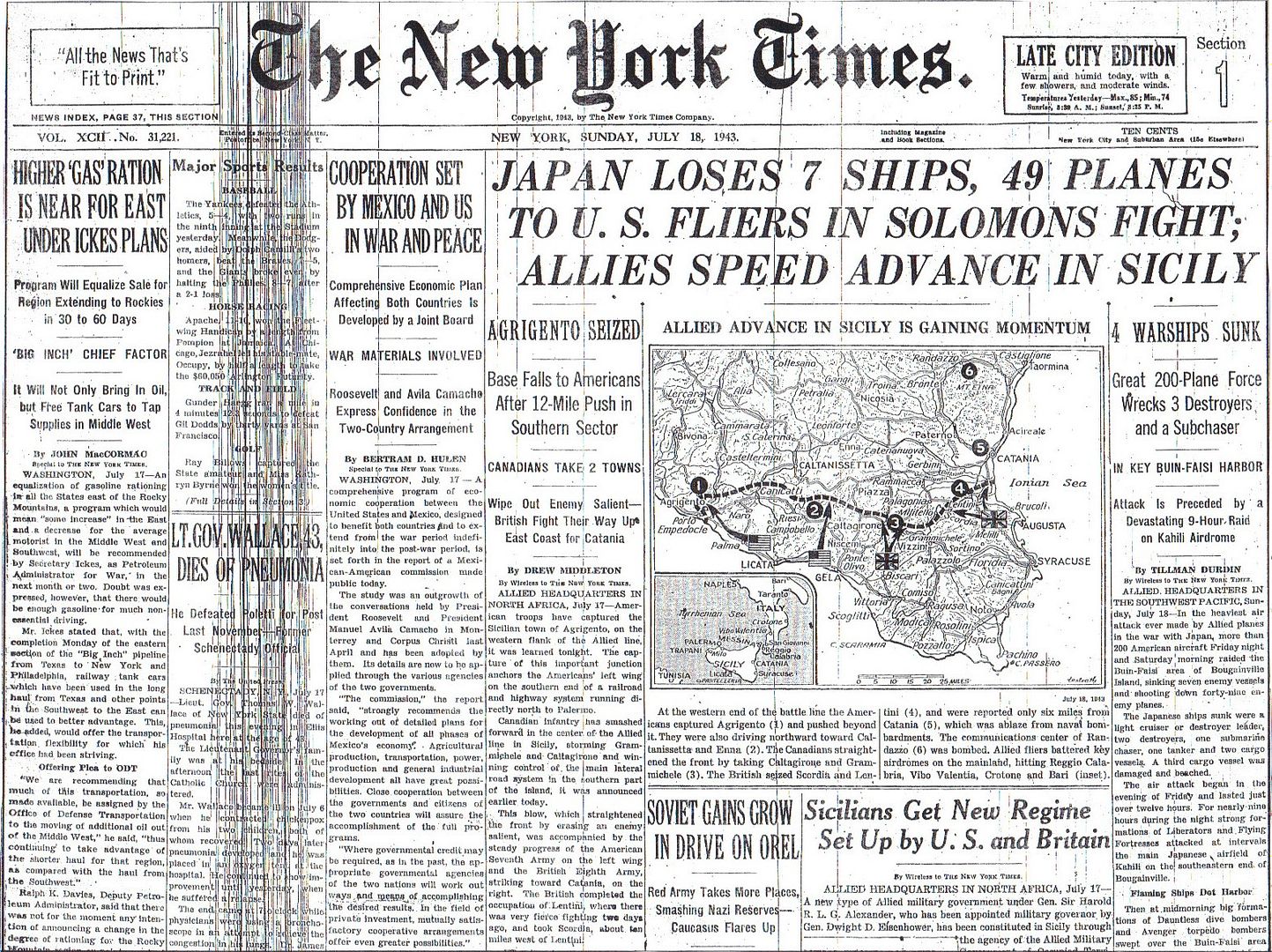
Posted on 07/18/2013 5:03:39 AM PDT by Homer_J_Simpson

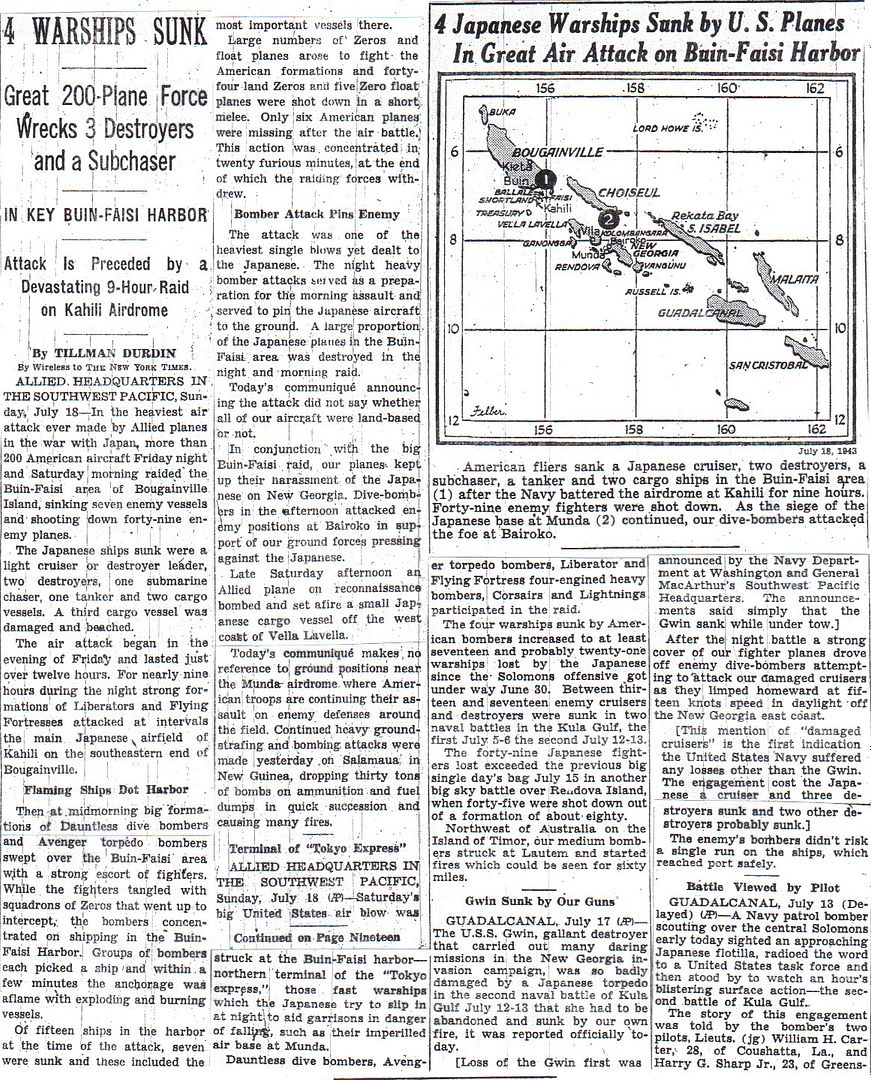

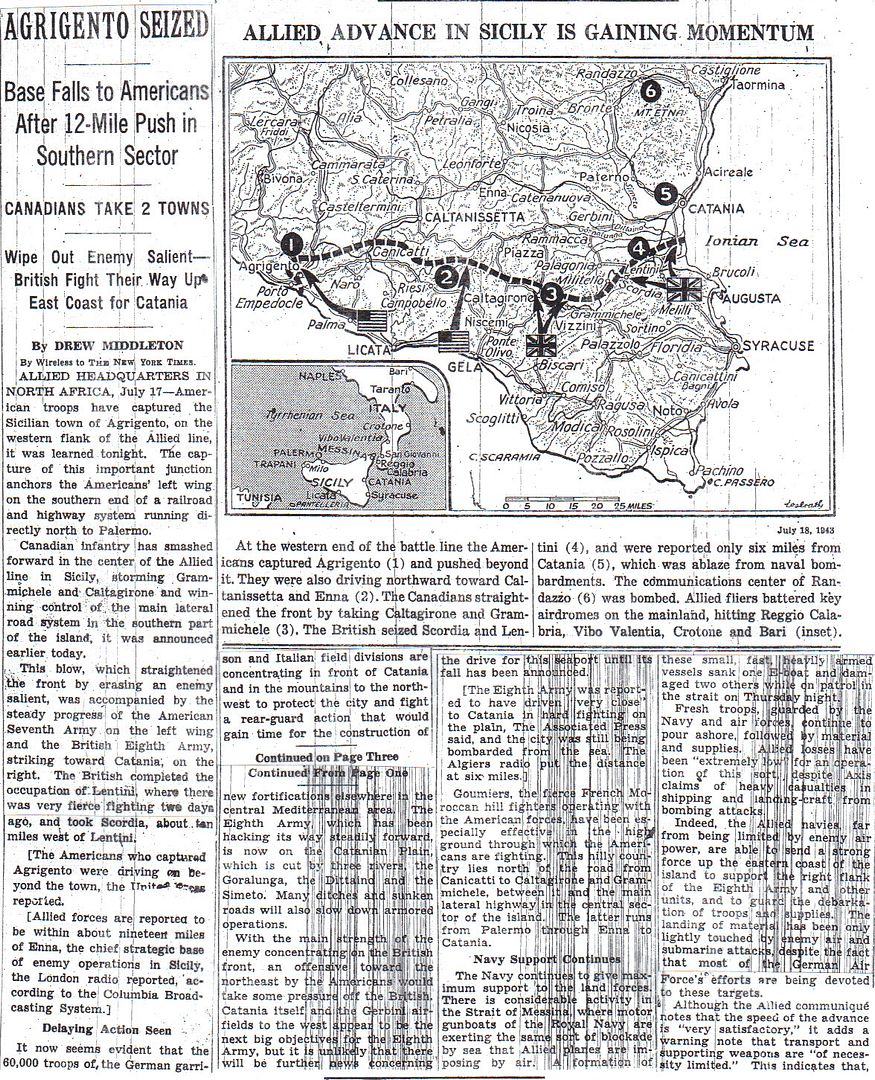
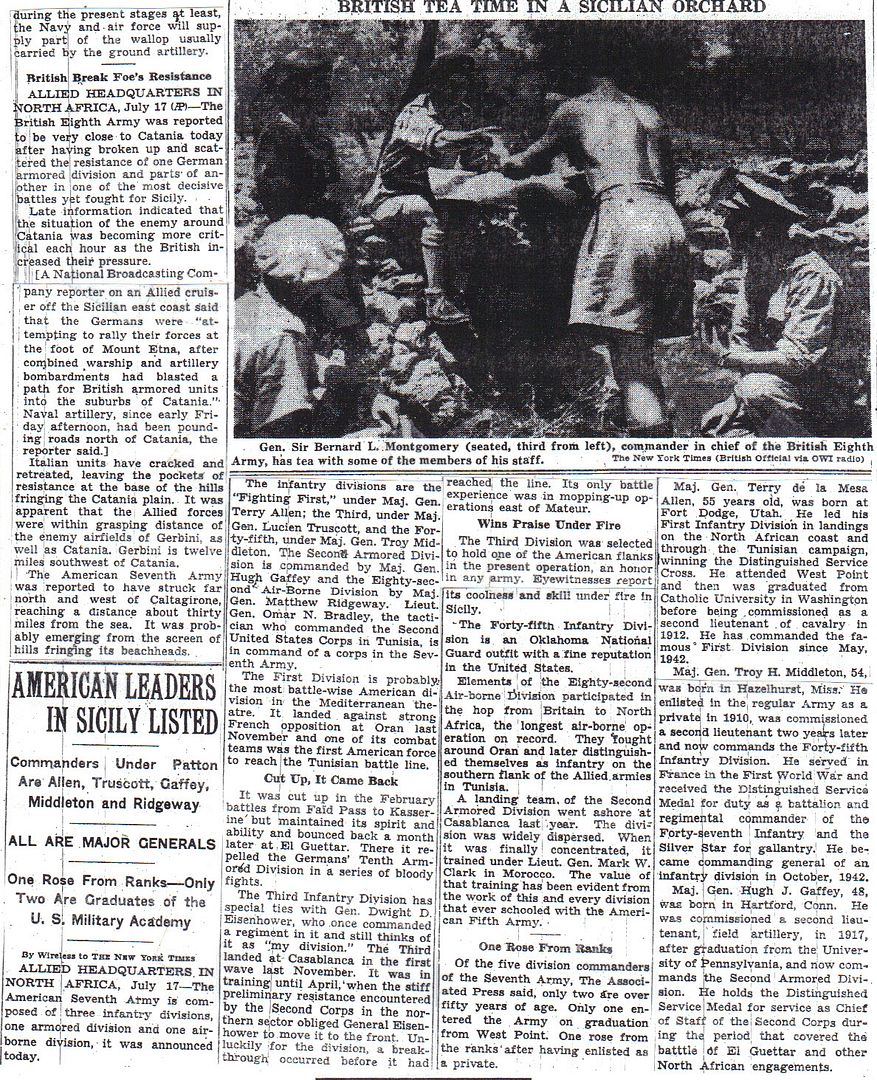
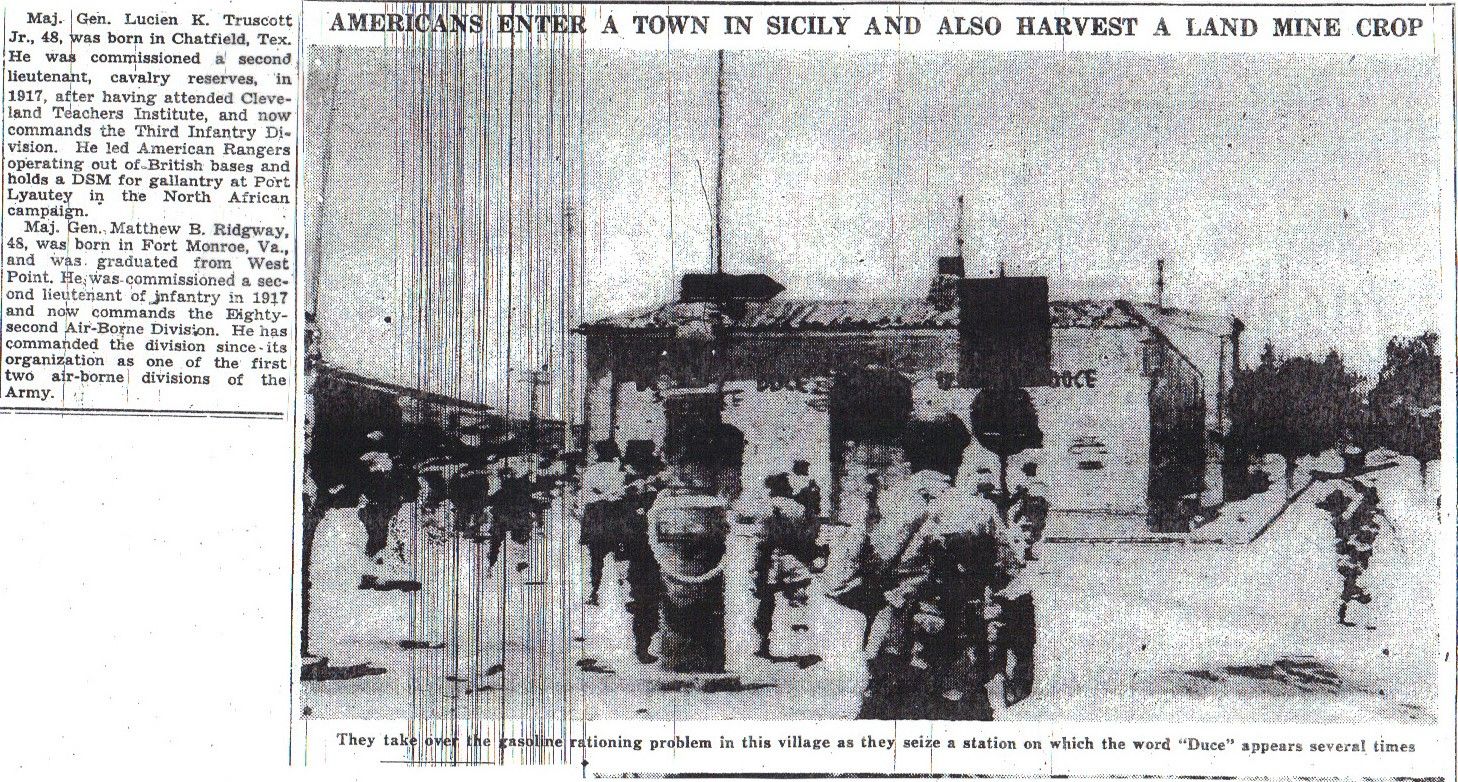
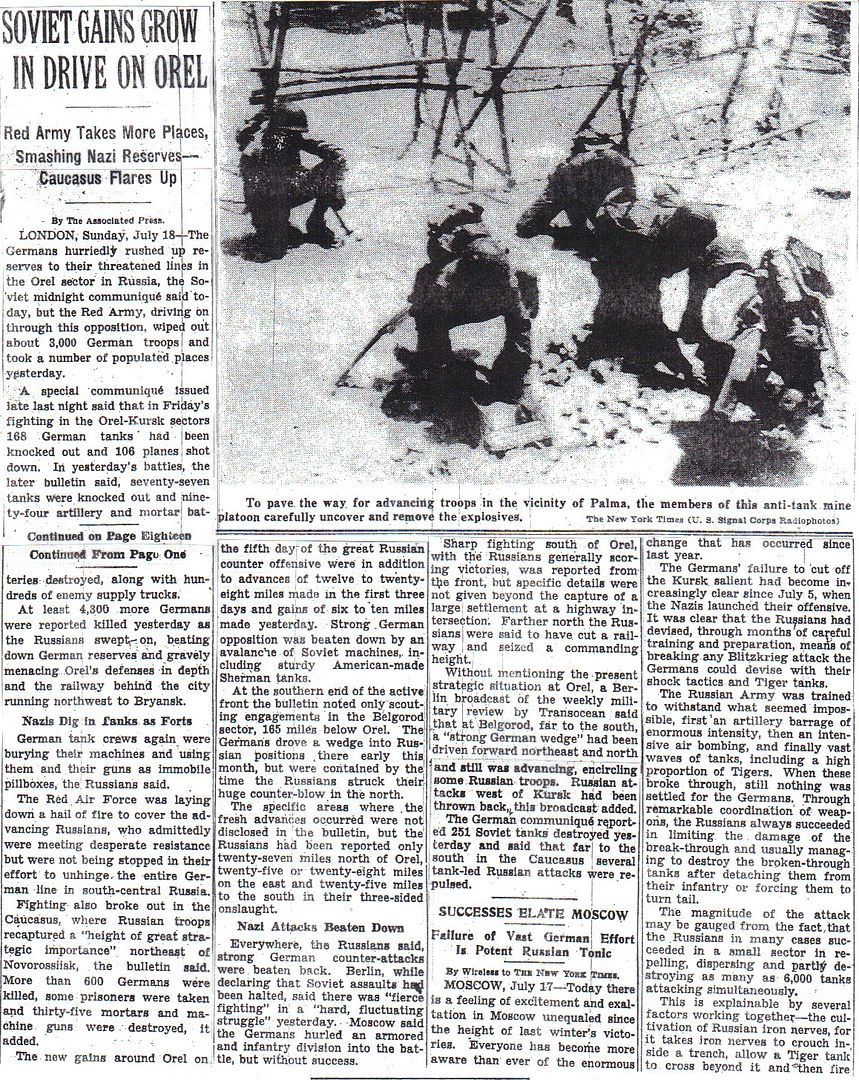

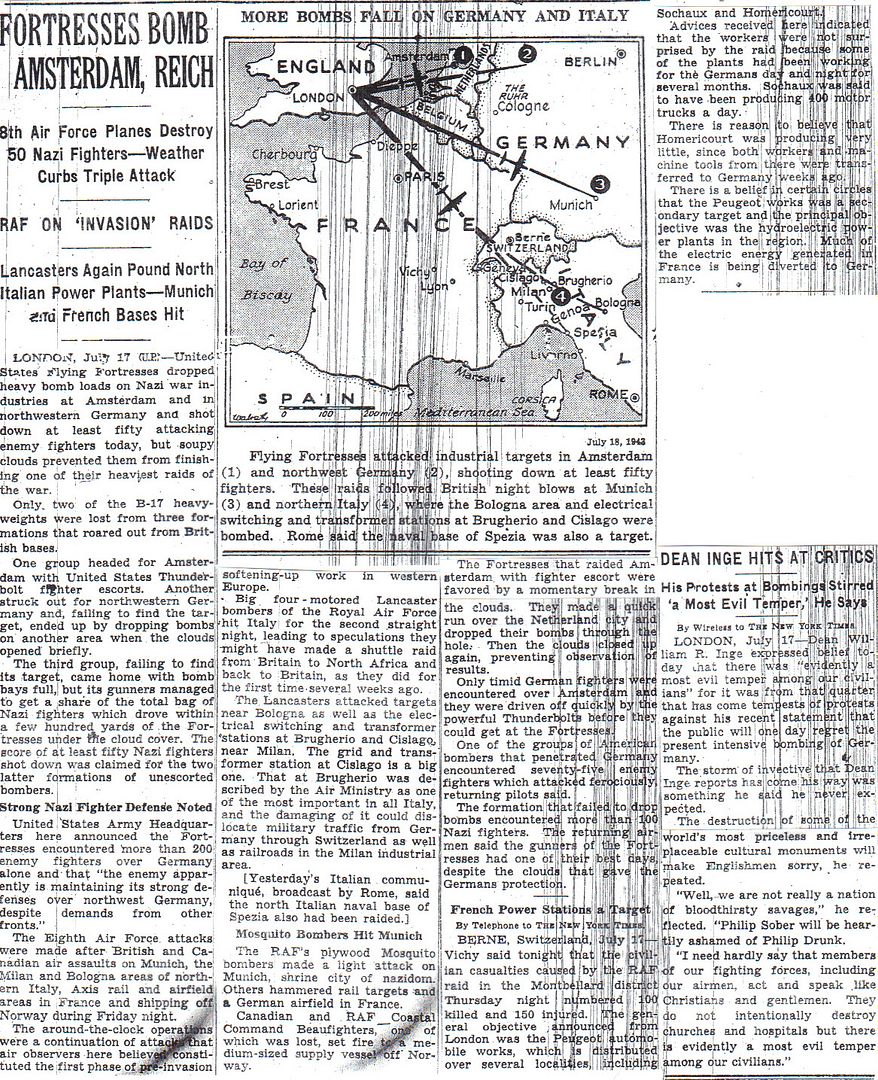
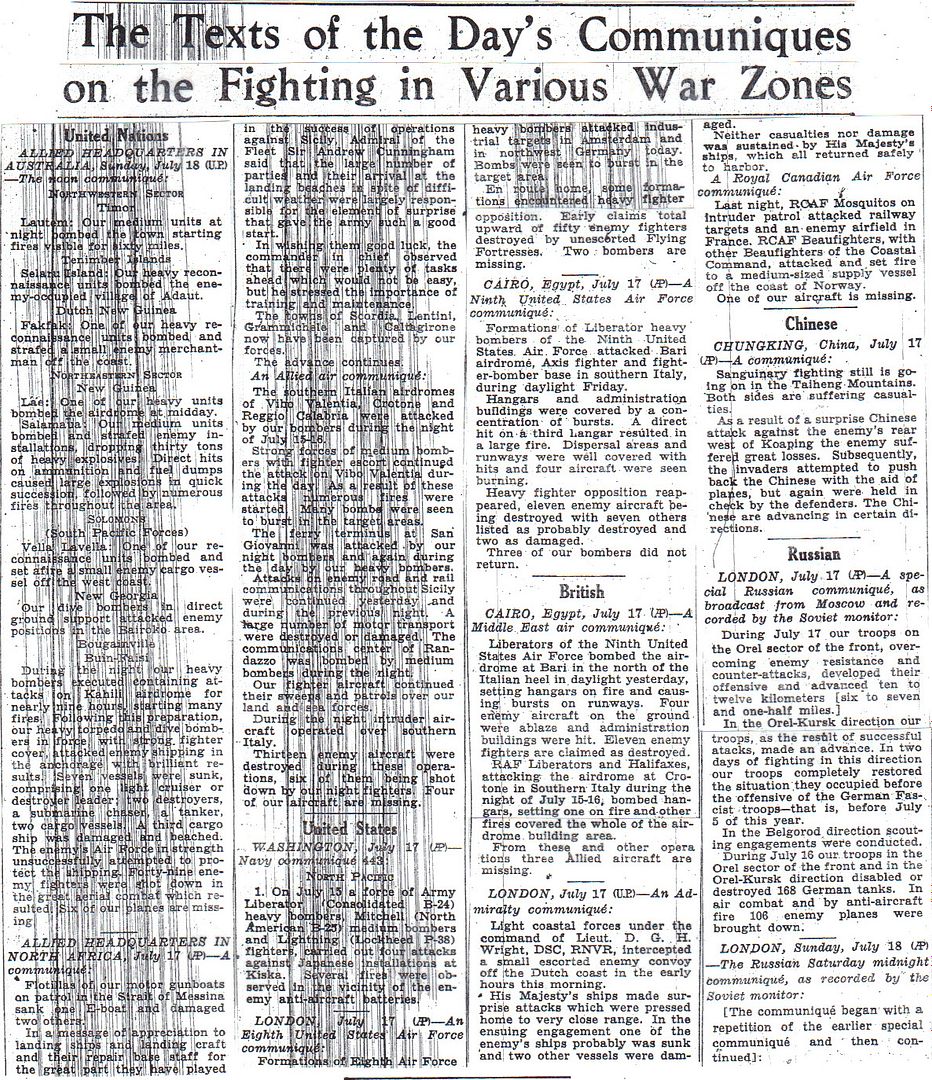
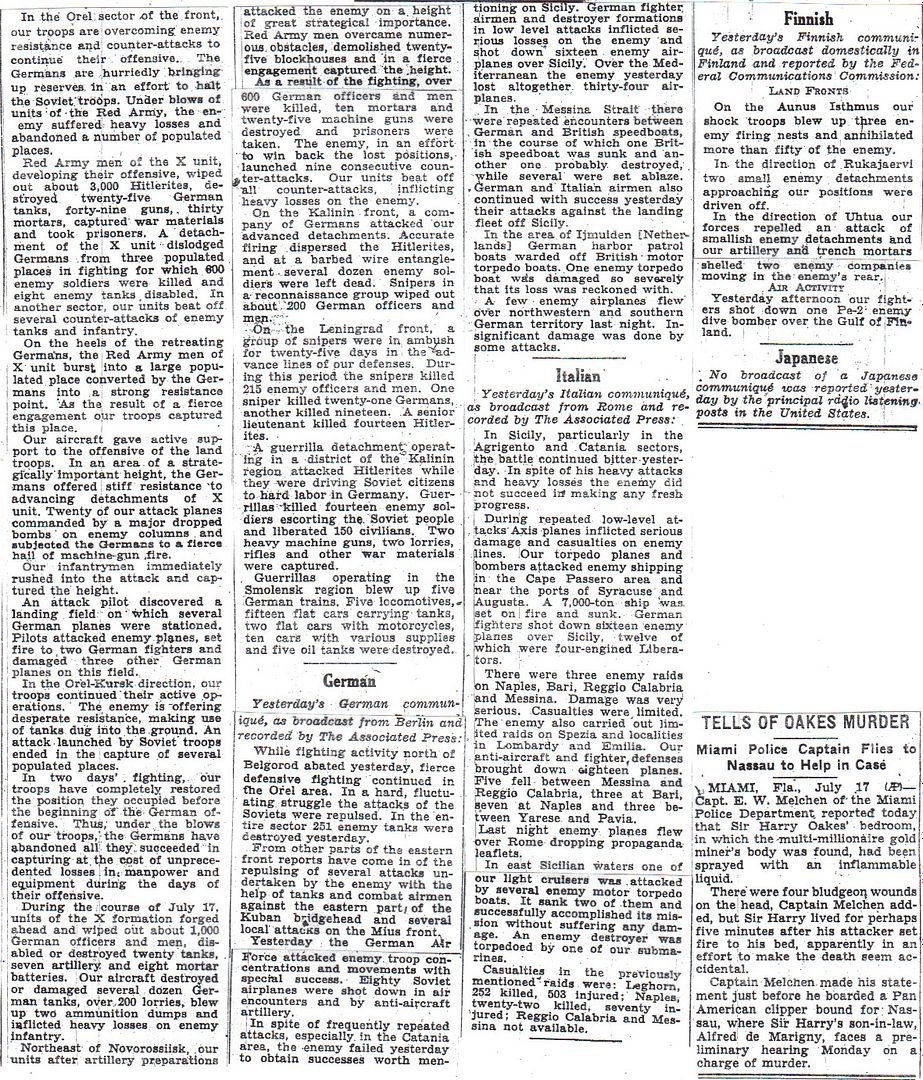

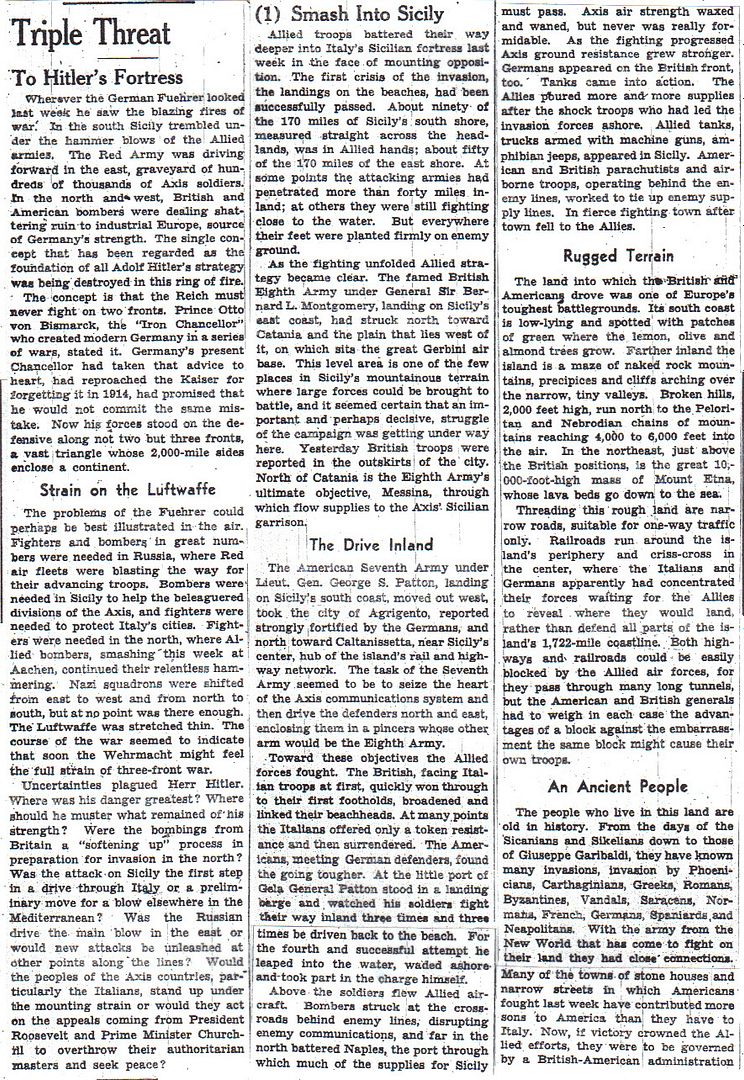
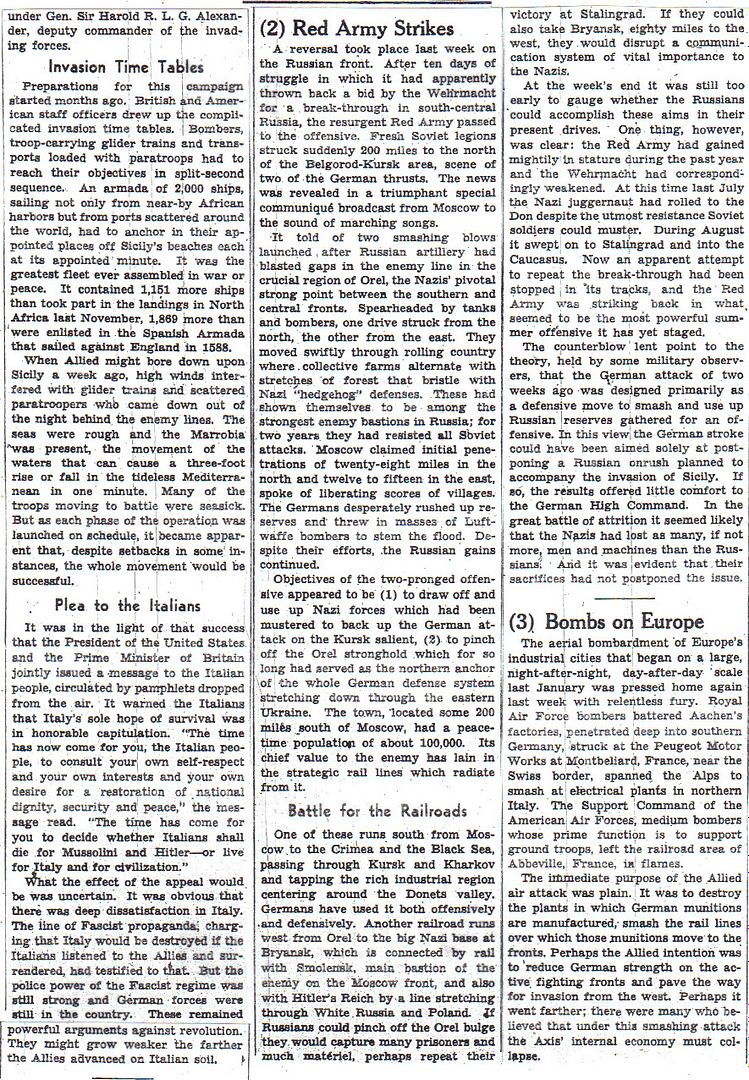
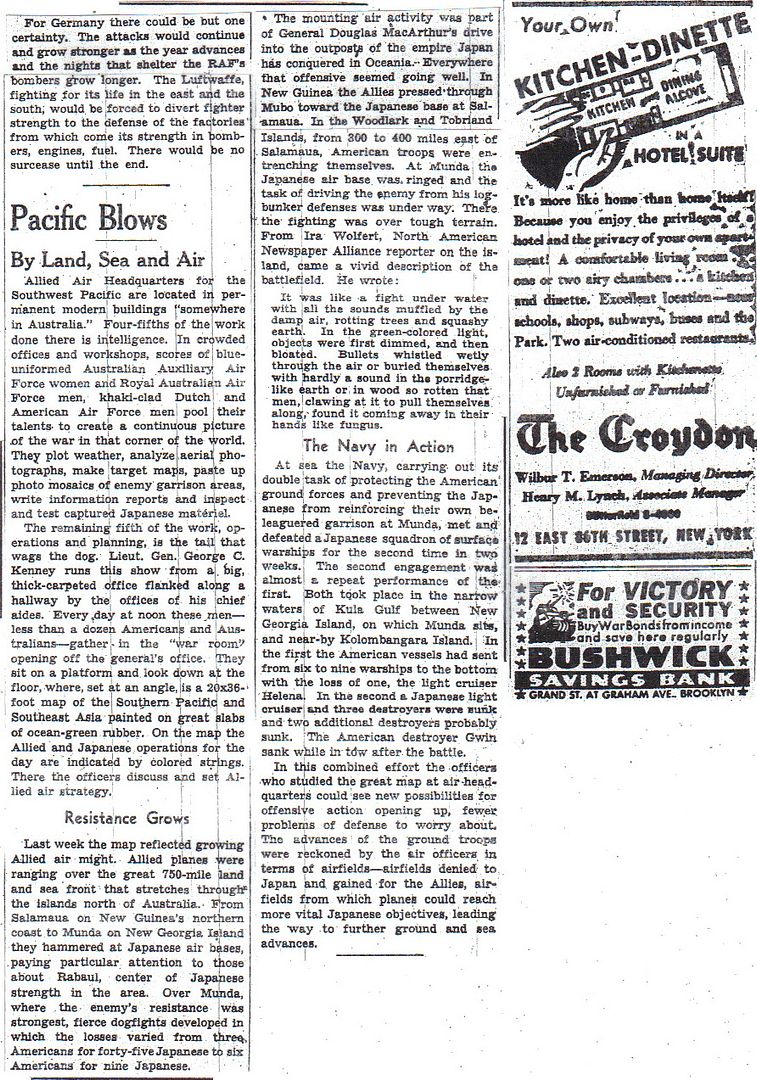
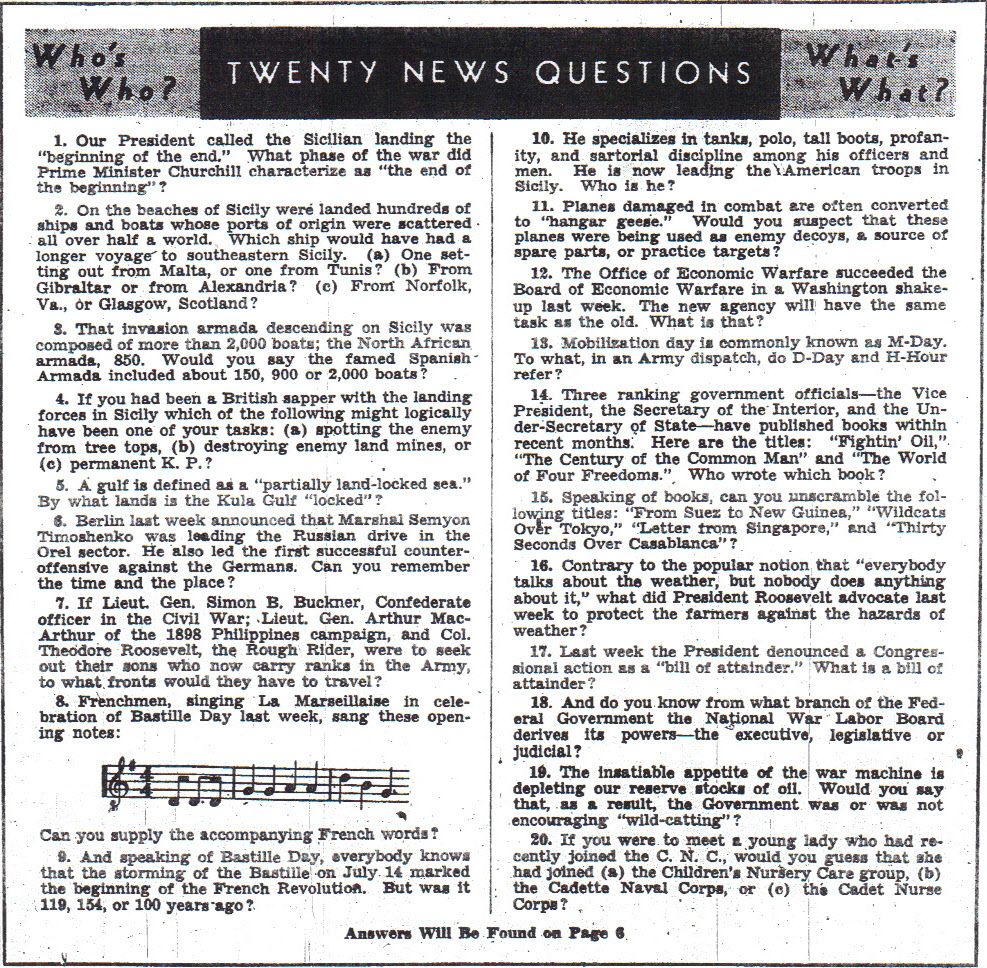

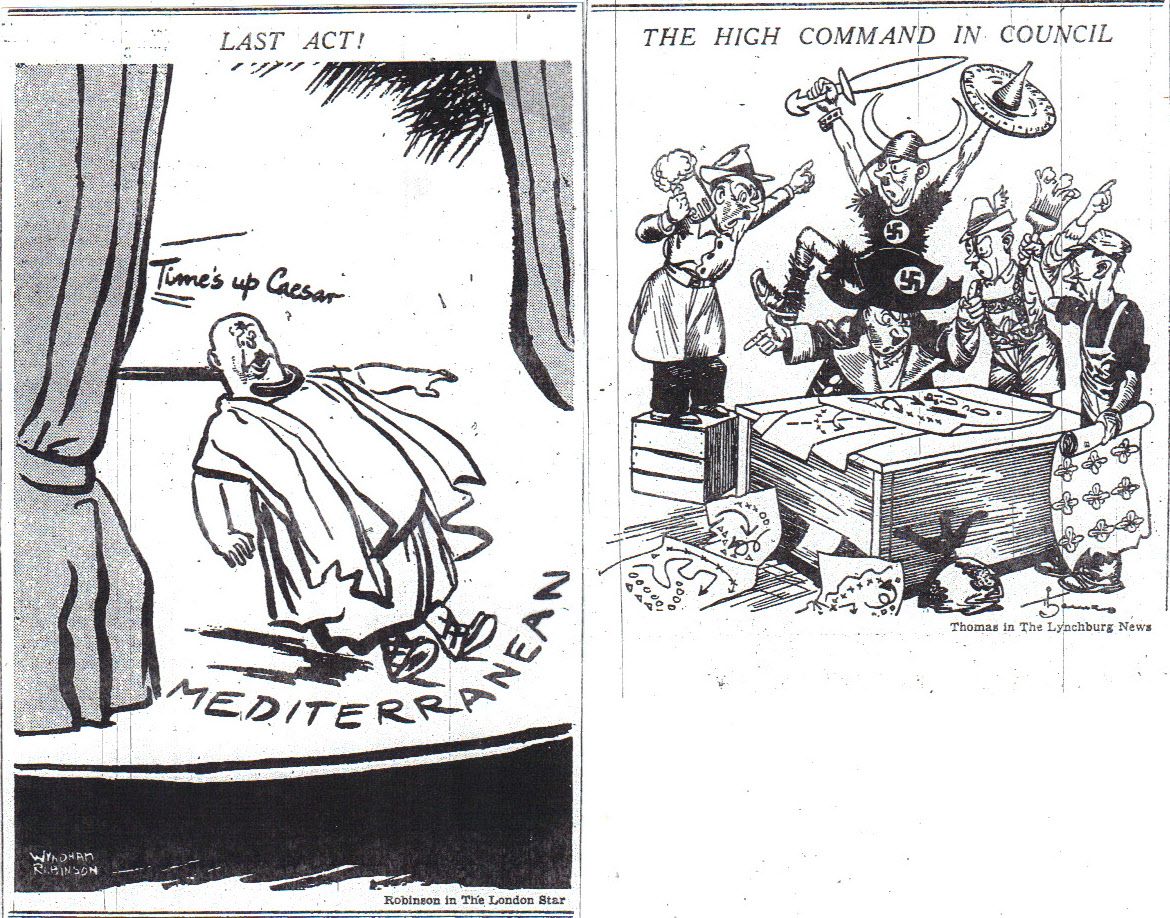
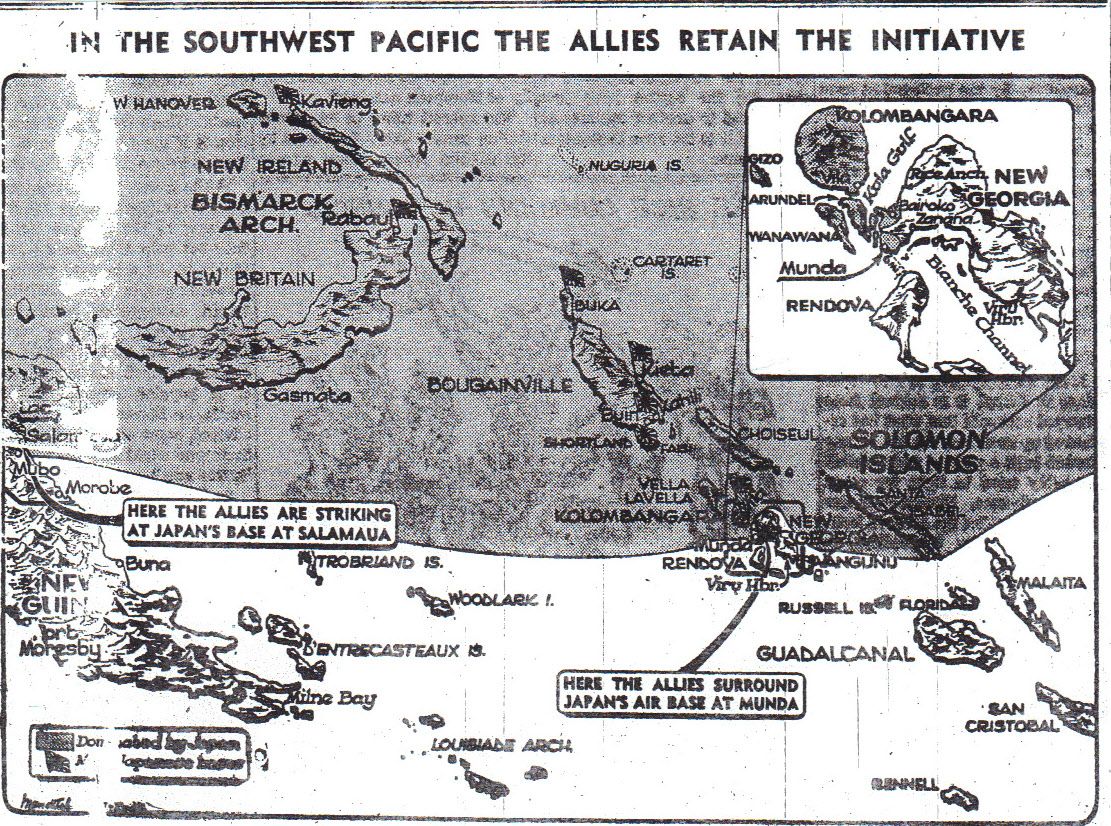


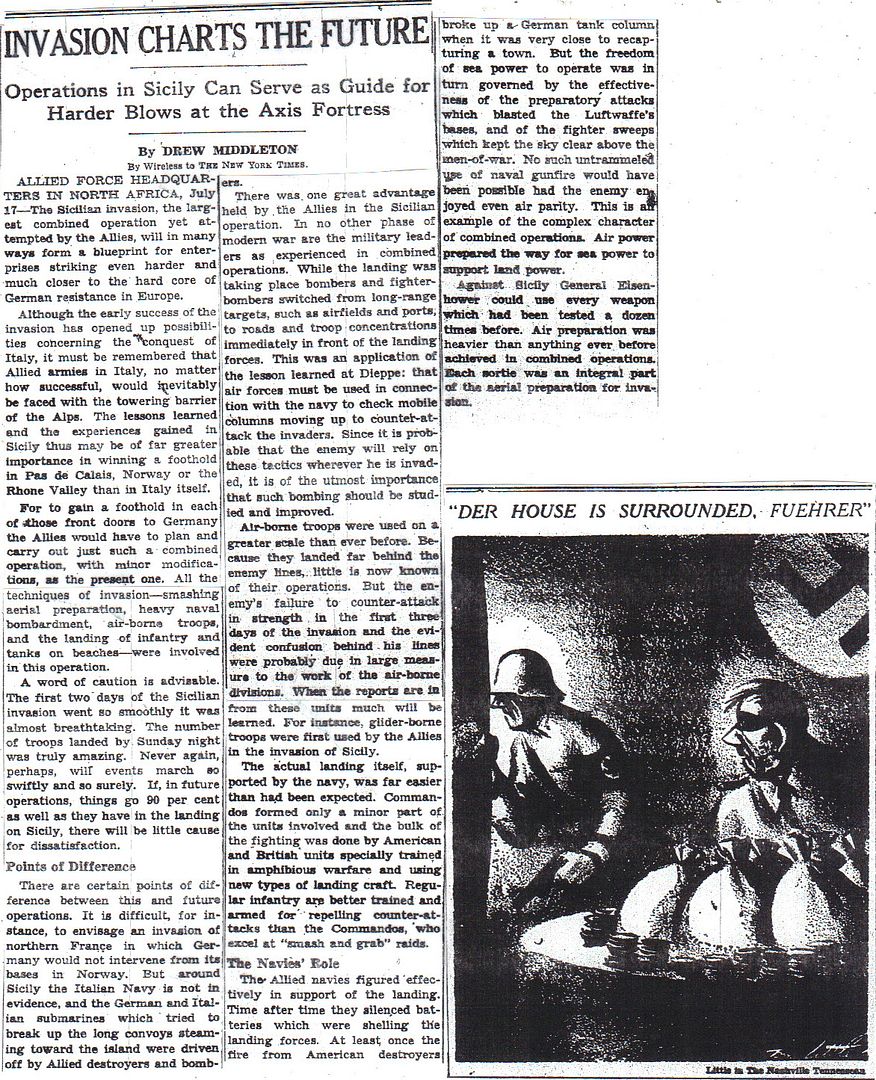
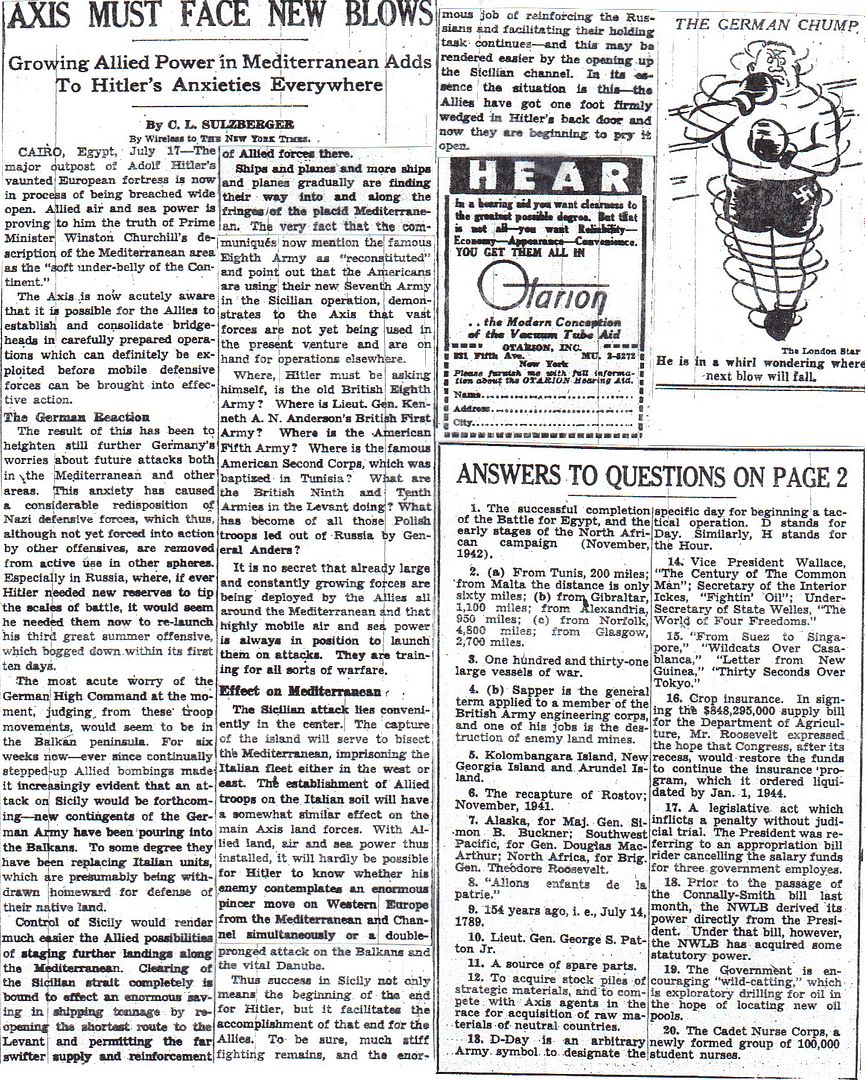
The News of the Week in Review
The Battle for Sicily: End of Round One (map) – 12
Triple Threat – 13-15
Pacific Blows – 15
Twenty News Questions – 16
Axis Feels the Weight of a Three-Way Attack (Baldwin) – 17
In the Southwest Pacific the Allies Retain the Initiative (map) – 19
Americans are Closing In on Munda (Durdin) – 20
Allies in Sicily Follow Path of Conquerors (Matthews) – 21
Invasion Charts the Future (Middleton) – 22
Axis Must Face New Blows (Sulzberger) – 23
Answers to Twenty News Questions – 23
http://www.onwar.com/chrono/1943/jul1943/f18jul43.htm
British held but Allies advancing
Sunday, July 18, 1943 www.onwar.com
Canadian Sherman tank moves through Valguarnera [photo at link]
In Sicily... Americans take Caltanisetta and cut the Palermo-Enna road to the north. East of Enna, Canadian forces capture Valguarnera. On the east coast, Dempsey’s forces are stalled north of the Simeto River.
http://www.etherit.co.uk/month/thismonth/18.htm
July 18th, 1943 (SUNDAY)
UNITED KINGDOM: Frigates HMS Loring and Pasley laid down.
ITALY: US Seventh Army forces capture Caltanisetta, Sicily and advance north rapidly against light opposition.
The British Eighth Army continue their advance, but strong German resistance halts Dempsey’s 13 Corps advance on the east coast near Catania.
Canadian forces take Valguarnerna.
In the air during the night of 17/18 July, Northwest African Strategic Air Force Wellingtons bomb airfields at Montecorvino, Sicily and Pomigliano, Italy, while Northwest African Tactical Air Force (light bombers bomb Catania, Sicily and carry out reconnaissance of extensive areas of Sicily. During the day, NATAF A-36 Apaches hit Santa Caterina, Adrano, Lercara, and Termini Imerese, Sicily.
JAPAN: 6 B-24s bomb shipping targets between Paramushiru Island and Shimushu Island in the Kurile Islands and the completed runway at Kataoka Air Base on Paramushiru Island, which is also photographed. They observe fires among buildings south and east of the runway. Some of the observed aircraft take to the air and vainly pursue the attackers. The strike on the Kurile Islands is the first heavy bomber attack against Japan during the war.
PACIFIC: In the Central Pacific, 6 Seventh Air Force B-24s, flying out of Funafuti Island in the Ellice Islands, bomb Betio Island, Tarawa Atoll in the Gilbert Islands. Japanese bombers raiding Canton Island in the Phoenix Islands are forced to jettison their bombs at sea because of intense AA and fighter defence.
SOLOMON ISLANDS: 21 B-24s, 20+ P-40s and P-38 Lightnings of the USAAF Thirteenth Air Force, and 35 US Navy and Marine Corps SBD Dauntlesses and TBF Avengers and 134 Navy F4F Wildcats and Marine F4U Corsairs thoroughly blast the Kahili area on Bougainville Island; 15 B-24s concentrate on the airfield; many AA positions are attacked, as are revetments and runways.
Hits are claimed on two destroyers, and a light craft is sunk. Twenty five A6M “Zekes” are shot down, 15 by F4F pilots and ten by F4U pilots; nine fighters and a TBF are lost. A B-25 off New Georgia Island strafes a motor launch.
ALEUTIAN ISLANDS: Two Eleventh Air Force B-24 Liberators and six B-25 Mitchells bomb Gertrude Cove and the Main Camp on Kiska Island.
U.S.A.: The only US Navy airship (blimp) shot down during World War II, K-74, is downed by the German submarine U-134 while on night patrol in the Florida Straits. For additional information on this encounter.
The USN airship K-74 assigned to Airship Patrol Squadron Twenty One (ZP-21) at Naval Air Station Richmond, Florida, lifts off on an antisubmarine patrol at 1909 hours local. At 2340 hours, radar detects a surface contact at 8 miles (12.9 km); the contact is the German submarine U-134. At 2350 hours, the airship begins an attack on the unsuspecting U-boat; the airship was at 250 feet (76.2 m) with a ground speed of 53 knots (61 mph/98.2 km/h) when the sub crew sighted the blimp and opened fire with light AA. The blimp crew returned fire with a 50-calibre (12.7 mm) machine gun which silenced the AA gun but the sub fired three rounds with a heavier calibre gun, one as the blimp approached and two as it passed over the sub. Orders were given to drop depth charges but a crewman’s error prevented this. The blimp’s bag had been punctured and the airship descended and hit the water at 2355 hours, the only airship shot down during the war. The airship remained afloat until 0815 hours on 19 July and the crew was rescued shortly thereafter; one man had been killed in a shark attack. U-134 had suffered damage to her main ballast tank and a diving tank and after being sighted by a land-based aircraft, she was ordered home for repair. While en-route, she was sunk on 24 August in the North Atlantic near Vigo, Spain by six depth charges from an RAF Wellington.
Destroyer escort USS Hilbert launched.
Destroyer escort USS Chase commissioned.
ATLANTIC OCEAN: At 0756, the unescorted Incomati was torpedoed and damaged by U-508 about 200 miles south of Lagos. At 0818, the U-boat began shelling the ship, setting her on fire and left the wreck in sinking condition. One crewmember was lost. The master, 101 crewmembers, eight gunners and 112 passengers were picked up by HMS Boadicea and Bridgewater and landed at Takoradi.
The USN airship K-74 assigned to Airship Patrol Squadron Twenty One at Naval Air Station Richmond, Florida, lifts off on an antisubmarine patrol at 1909 hours local. At 2340, radar detects a surface contact at 8 miles; the contact is the German submarine U-134. At 2350, the airship begins an attack on the unsuspecting U-boat; the airship was at 250 feet with a ground speed of 53 knots when the sub crew sighted the blimp and opened fire with light AA. The blimp crew returned fire with a 50-calibre machine gun, which silenced the AA gun, but the sub fired three rounds with a heavier calibre gun, one as the blimp approached and two as it passed over the sub. Orders were given to drop depth charges but a crewman’s error prevented this. The blimp’s bag had been punctured and the airship descended and hit the water at 2355 hours, the only airship shot down during the war. The airship remained afloat until 0815 on 19 July and the crew was rescued shortly thereafter; one man had been killed in a shark attack. U-134 had suffered damage to her main ballast tank and a diving tank and after being sighted by a land-based aircraft, she was ordered home for repair. While enroute, she was sunk on 24 August in the North Atlantic near Vigo, Spain by six depth charges from an RAF Wellington.
Note that Baldwin’s analysis (page 17) makes no attempt to exaggerate the western allies’ war efforts at the expense of Soviet Russia.
True; all of the other articles on the Russian Front mention that American Sherman tanks are fighting with the Red Army. These articles are giving rise to the myth that the Soviets beat the Germans with our equipment. The truth is that vast bulk of weaponry used by the USSR was home-built. Our most important contribution was trucks, about a million of them built in the United States and Canada. In fact, Studebaker made a very nice all-wheel drive heavy truck that was exclusively exported to the USSR. These trucks are not yet in front-line service in great quantity, but they will be next summer. In 1944, they will give the Soviet tank armies the “legs” they need to drive deep into German rear areas.
To some extent the Soviets are responsible for this myth. With their paranoid penchant for secrecy, they did a poor job of marketing themselves to the West. Nice “touchy-feely” articles about the regiment of T-34s purchased by the Orthodox Church, the “night witches” female bombing squadron, or a western journalists’ tour of the gigantic T-34 factory at Chelyabinsk would have done wonders in the American press. For a regime that lived on propaganda, they were actually pretty crappy at it.
But yes, Baldwin realizes that the hinge of this global war is the “war within a war;” the struggle between the Wehrmacht and the Red Army.
Of course, as we learned in an exchange a few weeks ago, there really aren't any scenarios where the Germans and Russians would never have fought during the war.
Not only are there not many scenarios where the Germans don’t fight the Soviets, I don’t know if there are that many scenarios where the Germans beat the Soviets. The only one I can think of is that the Germans go into the campaign with the idea of fighting a two-year campaign instead of six months, do a better job of organizing Western Europe’s resources and industry to support the campaign, and somehow manage to up-gun their panzers very quickly in response to the T-34.
But in a few months from now, after the Soviets crack the German line on the Dnepr River, Stalin will tell his generals he doesn’t need a second front to beat the Germans; he can do it alone. By then, he was probably right.
I also agree the Russians could have one it without the second front, but I'm sure glad we went in and all Germany didn't become a Soviet satellite.
It's been quite a few years since I read it and the book got away from me in a move but if I remember correctly, Otto Skorzeny wrote in My Commando Operations that Hitler told him had he known the Russians had so many tanks, he would not have attacked them.
I don’t know if there are that many scenarios where the Germans beat the Soviets.
I also seem to recall Skorzeny writing that in the first half of 1943, both sides were extending armistice feelers in what Skorzeny termed the Ankara Affair. The failure of Operation Citadel removed any prior Soviet interest in an armistice.
Several of the German Generals went on record after the war expressing a belief that had Hitler allowed a "flexible defense", the Germans could have bled the Russians white and forced an armistice. Instead, owing to Hitler's not one millimeter back mentality, German retreats were undertaken in desperation following Soviet breakthroughs.
An army here and an army there and pretty soon you've lost a whole lotta troops. The best General Staff in the world and Hitler overrules them to make bonehead decisions over and over.
I think if the Russians had cut an armistice with the Germans it would only be for the purpose of buying time to gain strength to get back whatever they had to give them.
Knowing Stalin, I agree. The key for the Germans would have been for Stalin to have been deposed in one manner or another.
Disclaimer: Opinions posted on Free Republic are those of the individual posters and do not necessarily represent the opinion of Free Republic or its management. All materials posted herein are protected by copyright law and the exemption for fair use of copyrighted works.